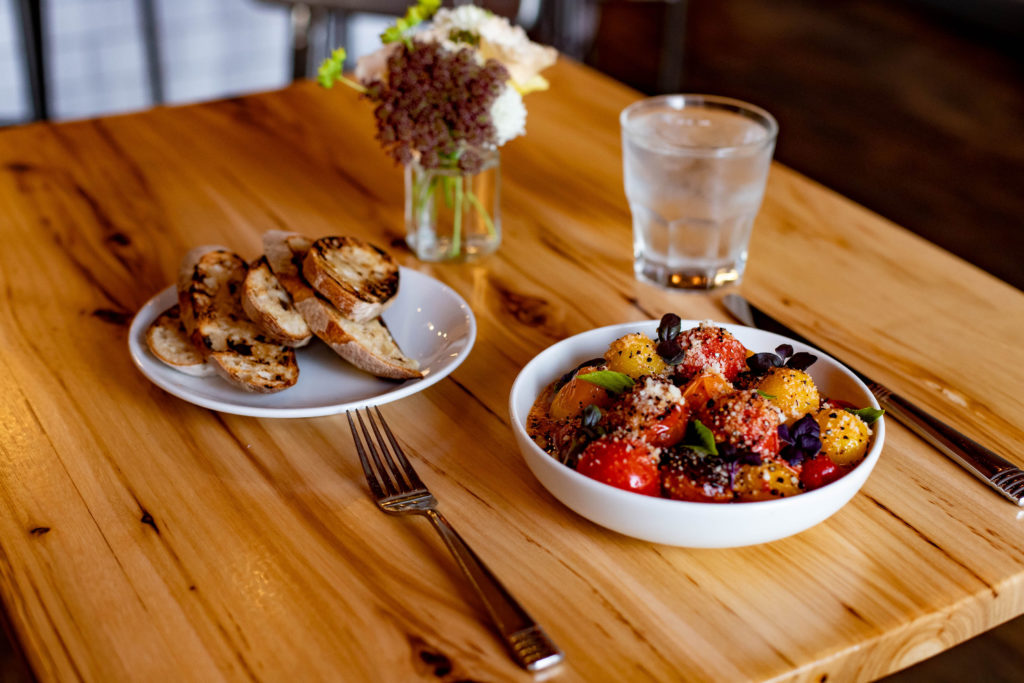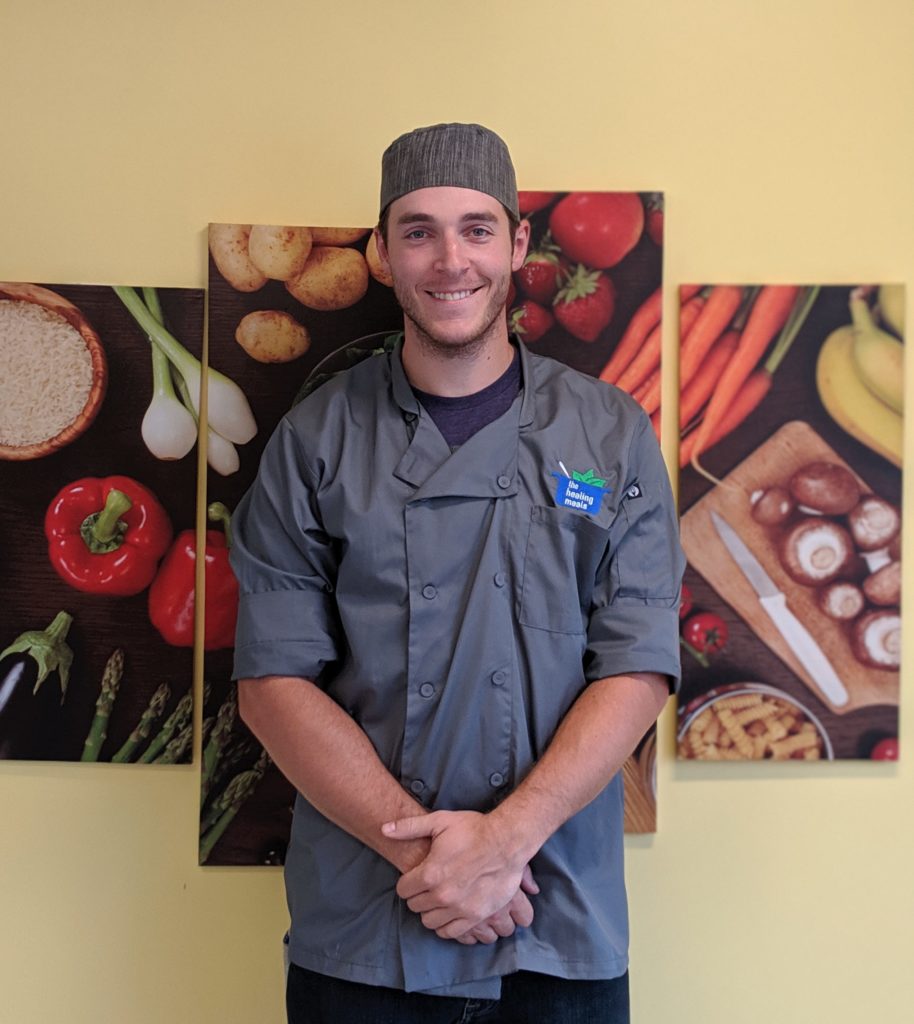Peppers, tomatoes, melons, herbs – our varied climate here in the Capital Region has an almost embarrassment of riches when it comes to stocking our kitchens with the best in local produce. But even farmers market die‐hards sometimes have a hankering to step away from the kitchen. Luckily, many top chefs at hot spots around the area are designing seasonal menus and dishes around this yummy upstate harvest.
Tomatoes to the core
Brendan Dillon opened Hamlet & Ghost in Saratoga Springs (24 Caroline Street; hamletandghost.com) in February of 2016 as a cocktail bar that served an upscale bar menu of charcuterie, Korean tacos, burgers, and pizzettas. Even though he wanted a buzz‐worthy bar serving artisanal cocktails, he always knew that a comprehensive food program would play a big part in his grand scheme. “We all realized we liked serving cocktails with food,” Dillon says “For me, there is something a little more rewarding about doing food and drinks together.” Then a terrible fire on Thanksgiving Day 2016 became a lesson in silver linings – and ultimately paved the way for his grander vision: “We were given some options,” he says, “about how we wanted to continue,” including an opportunity to take over the space next door after another tenant was allowed out of his lease. “We built out a new kitchen and added a new seating area,” including a chef’s table overlooking the new open kitchen. “We knew we were going to need to be more food‐focused and have a bigger menu.”
In 2018, executive chef Michele Hunter joined the team and, with Dillon, continued to build on what he started after the post‐fire re‐opening. Together, they have created an acclaimed seasonal menu that relies heavily on ingredients from around the area. “My sous‐chef and I will come up with different menu ideas, both inspired by which season it is and what farms have available and then…” Hunter begins before Dillon completes the thought: “I throw a lot of crazy at her, and she reigns it into what is realistic and executable.”
Hunter, who trained at the famed Culinary Institute of America (CIA), developed her famous Blistered Tomatoes (recipe pg. 16) using heirloom tomatoes and heirloom cherry tomatoes from Leaning Birch Farm in Broadalbin (2388 County Hwy 107; leaningbirchfarm.com). The family‐owned vegetable and flower operation is a Certified Natural Grower (CNG) that follows USDA farming guidelines. They grow more than 150 varieties of fruits and vegetables and are currently selling their harvest at Schenectady Greenmarket, the Glens Falls Farmers Market, and as a pop‐up in front of Roma Imports in Saratoga Springs on Saturday mornings. They also sell through their CSA and direct to stores and restaurants.
“Our menu uses single titles with descriptors, so this dish is simply ‘Blistered Tomatoes,’” Dillon says. It is an ode to the Catalan dish pan con tomate and an Italian bruschetta. “We keep our menu descriptions pretty basic, so the dish is a surprise when it’s served more complex than how it reads on the
menu.” This “tomatoes to the core,” tomato lovers’ dream uses five varieties of cherry tomatoes. “I take the cherries,” Hunter says, “and toss them with olive oil, a bit of salt, and blister them in the broiler.” Dillon says: “There is something about how good warm tomatoes are, like they just came out of the sun, just came off of the vine.”
Dillon recommends pairing this dish with our cover cocktail, the Blueberry Hill (recipe pg. 12).
Pickling for Later
What’s more refreshing on a hot summer day than juicy watermelon? Around our Capital Region, we are blessed with many varieties, each bringing different characteristics to the plate. On the week I visited with the chef and co‐owner of Troy’s Nighthawks, (461 Broadway; nighthawkstroy.com) Josh Coletto, he had just brought in a slew of Little Baby Flower watermelons from the Poughkeepsie Farm Project. The melon is small, about the size of a baby nerf football, its rind a rich verdant green color protecting a sweet interior.
Coletto caught the cooking bug at a young age. He first learned from his older sister before having a pivotal experience going on a day trip to the famous CIA, with his mother when he was 12. “I remember eating there, and it was one of the first times I ate something and was blown away by food,” he says. From that moment on, he knew his path was in the culinary arts. He took all of the food courses he could throughout the rest of his schooling and began working in a restaurant as soon as he was old enough to work in the kitchen. He then graduated from the two‐year program at CIA and moved to Portland, Oregon because of the booming food scene there.
While in Portland, he worked a lot, trying to gain as much experience as possible. He helped two of the three restaurants he worked at earn nominations as top Portland restaurants, which was a huge honor. “I learned so much being there and just going out to eat and trying to experience as much of that food scene as possible.” Colletto recalls that much of what was important in the Portland restaurant community back then is now migrating to the Capital Region, starting with the lust for farm‐to‐table cuisine.
For Coletto, the process of developing a weekly menu includes going through all of the farm lists to find out what is available, seeing what he has in his freezer, and checking on what is coming in from butchers or livestock farmers. Coletto butchers chickens and pigs in house, and has a partnership with Mike Lapi, a farm‐to‐table legend (who he met through the chef’s consortium) and instructor at the SUNY Cobleskill butchering program, where he has his beef butchered. “For me, to be truly farm to table you have to preserve and have everything you need for the whole year,” Coletto says. The afternoon I visited Nighthawks, the kitchen was a flurry of activity. Coletto had just brought in 300 pounds of tomatoes from Edible Uprising a new farm in Troy, (40 Springwood Manor; edibleuprisingfarm.com) and his staff was busy making and canning pickled green tomato relish, and canning and freezing tomatoes. They were also busy making sweet and sour pickled peppers and gearing up for preserving corn and fermenting in the coming weeks.
For his Watermelon Salad, Coletto chose the melons from Poughkeepsie Farm Project, a community farm and education program in the Mid‐Hudson Valley. His peppers were pickled in house and hail from Edible Uprising, just 2 ¼ miles from his restaurant in the heart of South Troy. He has seen great ingredients coming from their one‐acre, hand‐worked farm. Only in their first year, husband and wife team Ben Stein and Alicia Brown are growing more than 70 varieties of produce covering the full spectrum, from arugula to zucchini. They welcome visitors to their farm every Saturday to take in the bounty of the week.
Coletto’s passion is contagious, as is his philosophy that “all of this food is just super simple; it’s just really good ingredients. Everything about this restaurant to me is about letting the farmers’ work speak for itself. Do as little to it as you can to let it shine.”
 Watermelon Salad
Watermelon Salad
Courtesy of Chef Josh Coletto, Nighthawks (Photo by Konrad Odhiambo)
Ingredients, salad
1 small watermelon, cut up any which way
½ cup pecorino
½ red spring onion, sliced very thin
¼ cup sherry vinaigrette (recipe below)
¼ cup pickled peppers
(homemade is best!)
Ingredients, sherry vinaigrette
2 cups extra virgin olive oil
1 cup olive oil
2 cloves garlic, sliced thin
2 cups sherry
1 cup sherry vinegar
½ cup red wine vinegar
4 tablespoons Dijon mustard
Salt and pepper to taste
Instructions, sherry vinaigrette
• Place 1 cup olive oil and 2 cloves sliced garlic into a small pan; heat until you see bubbles. Kill the heat and let cool.
• Put sherry into a small pan and reduce to 2 tablespoons. Pour into a blender. Add sherry vinegar, red wine vinegar, Dijon mustard, salt, and pepper. Blend up for a second.
• Slowly drizzle in both the garlic oil and the extra virgin olive oil.
• Check the seasoning, adding salt and pepper if necessary. Store in a re-sealable bottle to use for a week or so.
Assembly
Place watermelon on a platter, and drizzle each piece with a little sherry vinaigrette. Arrange the pickled peppers and onions all across the watermelon. Grate a bunch of pecorino all over everything. Eat it!
Chef Coletto suggests pairing this salad with a Grüner Veltliner. He likes the house white at Nighthawks, the Von Kisel Grüner Veltliner from Austria, and says, “It’s quite tasty!”
 Blistered Tomatoes
Blistered Tomatoes
Courtesy of Chef Michele Hunter, Hamlet & Ghost (Photo by Konrad Odhiambo)
Ingredients, tomato vinaigrette
All of your roasted tomatoes and garlic (see below)
2 tablespoons apple cider vinegar
2 tablespoons white balsamic vinegar
¼ teaspoon ground coriander
¼ teaspoon ground caraway
1/8 teaspoon ground cardamom
Pinch of nutmeg
Salt to taste
1/2 cup extra virgin olive oil
1/8 teaspoon xanthan gum (optional)
Ingredients, roasted tomatoes
1 large heirloom tomato
3 cloves of garlic
Extra virgin olive oil
Salt
Instructions, roasted tomatoes and garlic
• To prepare the roasted tomatoes, cut the tomato in half and shove the garlic cloves inside. Coat the tomato with olive oil and salt. Roast in a 450˚ F oven for about 30 minutes, or until tender and gaining color. Allow tomatoes to cool. Strain out the liquid, and reserve.
Instructions, tomato vinaigrette
• Blend the first eight ingredients in your blender until very smooth. With the blender still running, stream in the olive oil slowly to create an emulsion. Season generously with salt. If using xanthan gum (this is used to make the vinaigrette thicker to coat the tomatoes), add slowly while the blender is running. Blend on high to ensure it is well mixed.
Instructions, toast
• Use slices of your favorite sourdough bread. Drizzle lightly with olive oil. Grill them or bake them to desired color. When they are done, but still hot, rub them with some raw garlic cloves. This will give the toast some fresh spicy garlic flavor that compliments the tomatoes beautifully.
Assembly
Toss your desired portion (we use about 18 per dish) of heirloom cherry tomatoes with olive oil and salt. Using a broiler on the high setting, allow tomatoes to blister and gain color. When the tomatoes have popped and have a small amount of char, they are done.
Remove from the broiler and toss with the tomato vinaigrette. Place in your serving dish. Sprinkle the following ingredients on top, and you’re ready to serve!
1 tablespoon reserved roasted tomato liquid
1 teaspoon Urfa Biber
1 teaspoon cracked grains of paradise (or black pepper)
1 tablespoon pecorino romano
2 tablespoons basil (we use micro opal, but any small basil leaves will work here)
1 tablespoons beef fat, optional (bacon fat would also be extremely tasty!)
Hungry for Growth
Serving up much-needed support for local food startups with a craving for success.
Here in the Capital Region, we are known for our dedication to small businesses‐that‐could. We love seeing our upstate neighbors get a start locally then flourish on a national scale…hello, GE! And let’s not forget intergalactic Death Wish Coffee, Legacy Juice Works, Rad Soap, and Saratoga Water. What a line‐up. This dedication to Silicon Valley‐worthy innovation and invention has lead to the development of many local incubators over the years, startup accelerators that have sprouted some amazing success stories, from sustainable mushroom‐based packaging and gaming companies, to top software developers. Nationally, major metropolitan areas have recently started turning to food‐specific incubators to offer entrepreneurs with the next best edible concept a more targeted place to experiment, develop, and create their products. Over the last year, our Capital Region has brought the trend closer to home. Let’s dig in.
A Need and a Seed
For the nonprofit Capital Roots, the concept of a bona fide cuisine‐centered incubator was sown 15 years ago when its board began conceptualizing the long‐term plan for its Urban Grow Center (UGC) in Troy. Recognizing that the desire to have locally made and locally sourced food products was very much a part of the fabric of our community, and interwoven with their mission to create a “Capital Region where every person has access to fresh, affordable, healthy food,” the development of a comprehensive food incubator seemed a natural progression.
Capital Roots has watched many would‐be food entrepreneurs begin down the path to business ownership, only to get sidelined by the prohibitive costs and confusing processes of starting in this industry. Many don’t even make it past the first major step ‐ fitting up a suitable kitchen. Not only are you paying for the space and any construction that is needed, but you have to shell out for equipment, licensing, and typical legal fees that may be associated with starting the business. Costs add up, and all of these lengthy processes take time, sometimes in excess of 18 months.

As Capital Roots breaks ground on the UGC’s second phase, which includes its incubator, Albany’s Chris Small is up and running with his “Chef’s Kitchen Space.” A longtime food enthusiast, last year he realized his dream of being a business owner in the food industry, before deciding that with his success came the opportunity to pay it forward. “I have always loved to cook and have always been in the kitchen,” he says of his motivation for The Healing Meals, a food preparation retailer providing ready‐to‐go meals and snacks, which he launched in 2018. “So many of my friends and family had issues with food,” whether it was an allergy or ailment, or if it was just taking the time and putting forth the effort to eating better “I just wanted to give them an easier way to eat healthily.”
Once he was up and running, Small took a cue from other communities and started to rent out his newly furnished commercial kitchen to other startups during his off‐hours. “My business plan,” he says, “requires that I be in the kitchen only a couple of days out of the week,” leaving the space available. Through Chef’s Kitchen Space, Small also provides access to a network of associates that entrepreneurs can tap into to obtain requisite insurance, business credentials, and contacts at various state and local agencies.
Small requires any potential renter to secure either a DBA or LLC and insurance before beginning the inspection process and entering into a rental agreement. His program has become so respected that outsiders have fraudulently claimed to be one of his approved renters. He is vigilant about correcting this and continually works to find the appropriate businesses to share his space.
Taking Root and Growing
Back in Troy, the second phase of the UGC, which opened in 2014 upon completion of Phase I, is breaking ground this fall. The much‐anticipated food incubator will be one of the first spaces completed, with construction scheduled for about 12 months. The commercial kitchen is designed to include four unique spaces, accommodating four processes simultaneously and will be available to participants 24/7. “It is going to be great!” says executive director Amy Klein. “The kitchen will be accessible using a key‐pad entry so that participating entrepreneurs can have access when they need it.” She envisions producers requiring the kitchens, which will be furnished to handle large‐scale productions, at staggered times throughout the day. “The four independent spaces will include one ideally set up for baking, two for cooking, and a fourth that can accommodate a variety of processes,” she says. “So perhaps a baker will be in the kitchen during the very early morning, and then some will have a day job schedule that they are working around and need access later in the evening.”
Additionally, the food‐based business incubator is designed to support owners through the start‐up process by partnering with Community Loan Fund and other local businesses and networks, providing a group of mentors and support as well as the ability to tap into and purchase directly from the Capital Roots hub of more than 80 local farms and their on‐site greenhouse array. “The produce from our hub and greenhouses will be available for wholesale purchase by the entrepreneurs and will be delivered right to the on‐site kitchen space,” Klein says, explaining how easy and seamless the relationship will be between farmer and producer. UGC is also planning on increasing the footprint of its existing marketplace by more than 12 times its current size. It will be open to allow for foot traffic, and Klein envisions a large lunch crowd from surrounding businesses and offices. “Our in‐house market space will give the participants a great space to test‐market products in real‐time.”
With a set‐up that perfect, the only question left is – who’s hungry for success?







